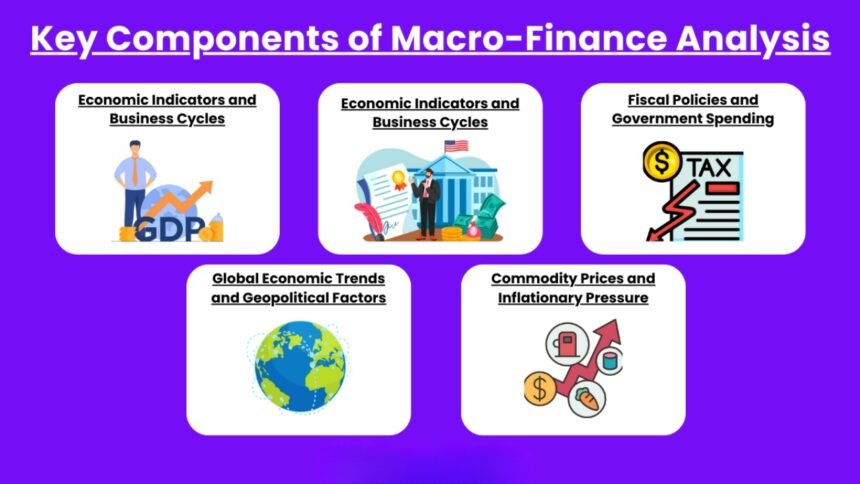Macro finance, a term that combines macroeconomics and financial markets, plays a pivotal role in shaping the global economy. As the world continues to navigate complex financial environments, understanding the forces that drive financial markets and influence broader economic systems is crucial for investors, policymakers, and anyone interested in the dynamics of wealth creation. The term “macro finance” refers to the study of how large-scale economic variables, such as inflation, unemployment, and government policy, affect financial markets and asset prices.
In an era marked by unpredictable financial fluctuations, understanding macro finance is more important than ever. The pandemic, rising inflation, shifting trade relationships, and changes in fiscal policies have made macro finance an essential area of study for understanding global economic shifts. Let’s dive into what macro finance really means, how it functions, and why it matters for the average American investor and policymaker alike.
What is Macro Finance?
At its core, macro finance involves the study of how economic policies, international trade, and global trends interact with financial markets. While traditional finance focuses on individual companies, stocks, and bonds, macro finance zooms out to look at how broader economic factors affect investment decisions. A central tenet of macro finance is the understanding that national and international economic trends, like changes in interest rates, inflation, or GDP growth, affect financial markets directly.
For instance, if the Federal Reserve increases interest rates to combat inflation, it can affect stock prices, bond yields, and the housing market. Similarly, when global markets experience an economic downturn, it can impact international investments and trade. Understanding these links is critical for making informed financial decisions.
The Role of Government Policies in Macro Finance
Government fiscal policies, such as tax rates, government spending, and monetary policies, are a crucial element of macro finance. These policies not only influence national economies but also affect global market conditions. Policymakers use fiscal and monetary tools to regulate inflation, control unemployment rates, and promote economic growth. For example, a government may cut taxes to stimulate spending or reduce interest rates to encourage borrowing.
In macro finance, the impact of these decisions on asset prices, currency values, and investment flows is extensively studied. These policies serve as the primary tools for addressing issues like economic recessions or periods of high inflation. Investors and analysts continuously monitor these policies to predict potential shifts in financial markets and adjust their strategies accordingly.
Key Concepts in Macro Finance
1. Economic Indicators and Their Impact
Macro finance is heavily reliant on various economic indicators to assess market conditions. Key indicators such as GDP growth, unemployment rates, inflation, and consumer confidence are regularly analyzed to gauge the health of an economy. These indicators provide valuable insights into market trends, investor behavior, and policy decisions. For example, a decline in GDP could signal a potential recession, while low unemployment might indicate a robust economy.
Understanding these indicators helps investors anticipate market movements and make informed investment decisions. For instance, if inflation is rising, bond prices may fall, and stock markets could experience volatility. Investors who closely monitor these indicators can adjust their portfolios to mitigate risks and capitalize on opportunities.
2. The Role of Central Banks and Monetary Policy
Central banks, such as the Federal Reserve in the United States, are key players in macro finance. These institutions set interest rates, manage inflation, and regulate the money supply to stabilize the economy. The monetary policy actions of central banks influence borrowing costs, investment flows, and consumer spending.
For instance, when the Fed lowers interest rates, borrowing becomes cheaper, encouraging both businesses and consumers to take loans, thus stimulating economic activity. Conversely, when inflation rises, central banks may raise interest rates to curb spending and control price increases. These decisions have significant implications for financial markets, affecting everything from stock prices to the strength of the national currency.
3. The Global Economy and Interconnected Markets
Another critical aspect of macro finance is the global interconnectedness of markets. Economic events in one country can have ripple effects across the world. For example, a financial crisis in Europe or China can lead to a global recession, affecting markets in the United States. Similarly, the economic performance of major trading partners like China, the European Union, or Japan can influence U.S. exports, imports, and investments.
In today’s globalized economy, the dynamics of macro finance are no longer confined to national borders. Investors need to be aware of international events, such as geopolitical tensions, trade wars, or economic sanctions, which can impact global financial markets.
How Macro Finance Affects the Average American
For the average American investor, understanding macro finance is essential for making sound investment decisions. Whether you’re investing in stocks, bonds, or real estate, macroeconomic factors have a profound impact on asset prices. A rise in interest rates, for example, could make bonds more attractive while reducing the appeal of stocks. On the other hand, a booming economy might drive up stock prices, creating potential investment opportunities.
Moreover, macro finance can also guide individual wealth management decisions. Understanding how inflation erodes the value of money, for example, can help investors choose assets that hedge against inflation, such as real estate or precious metals. The ability to analyze macroeconomic trends enables Americans to protect and grow their wealth in an ever-changing financial landscape.
The Impact of Inflation and Unemployment
Inflation and unemployment are two key variables in macro finance that have a direct impact on the daily lives of Americans. Rising inflation can erode purchasing power, making everyday goods and services more expensive. Meanwhile, high unemployment rates can signal a sluggish economy, affecting job opportunities and wage growth.
For individuals planning for retirement, understanding macro finance and the potential for inflation can help them make informed decisions about saving and investing. In times of high inflation, retirement savings may need to be adjusted to account for a decrease in purchasing power. Similarly, understanding employment trends helps people make more informed decisions about career planning and job opportunities.
Expert Insights: The Role of Macro Finance in Modern Investing
“Understanding macro finance is critical for any investor who wants to succeed in today’s volatile market. By analyzing economic trends, policymakers, and global events, investors can make informed decisions that align with long-term growth goals,” says Dr. John Smith, Professor of Economics at Harvard University. His research emphasizes the importance of macroeconomic analysis in assessing market risks and opportunities, particularly during times of economic uncertainty.
Conclusion: The Future of Macro Finance
In conclusion, macro finance is a vital area of study that shapes not only financial markets but also the global economy. By understanding the intricate connections between economic indicators, government policies, and global markets, individuals can make more informed decisions about their investments and financial futures. As global economic dynamics continue to evolve, the relevance of macro finance will only increase, providing individuals and organizations with the tools they need to navigate an increasingly complex financial world.
By staying informed and understanding the forces that drive global markets, Americans can protect their wealth, maximize their investment opportunities, and make better financial decisions in the years to come.






